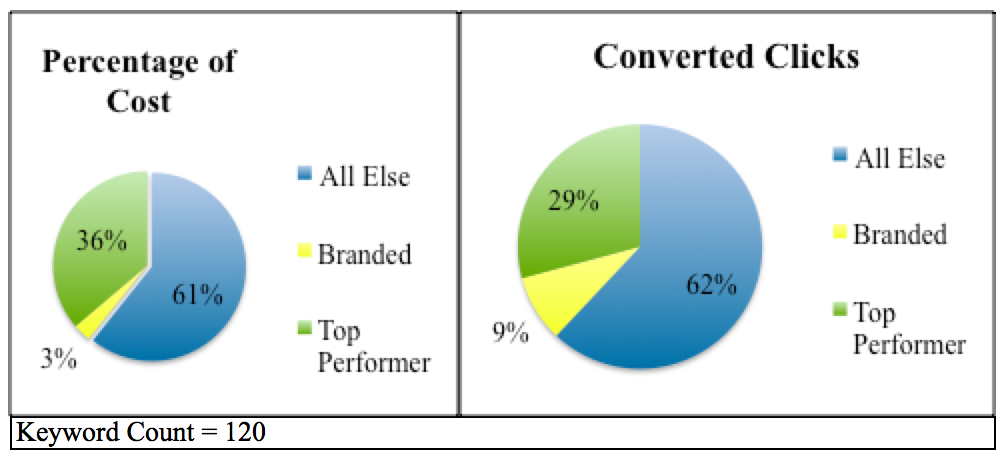Top Performer campaigns seem to be all the rage. They’re like the kimchi taco of the PPC culinary world. Some folks have been doing it for a long time while others have a vague understanding of what they’re doing, but launch into it anyway.
Instead of going through the motions of explaining why you need a Top Performer campaign, as there are many resources for that, let me simply sketch out for you one story of a Top Performer campaign and what it took to generate success.
Once Upon A Time….
An account once had a top performing keyword. Like, majorly top performing. The up-side and down-side of this keyword is that it is an exact match. We know exactly the searches that are generating the impression- no more, no less. But this hero keyword had a CTR that never fell below 5%, a conversion rate that consistently hit 10%, and a CPL that was all over the place. Wait- what? Yes, it was an extremely strong keyword, but bidding alone wasn’t allowing us to get the CPL to a reasonable point.
We’d pull back on bids, and the competition in this industry would thrust the keyword down in rank by a full position. We’d implement various bid adjustments and see little to no difference except for our overall volume, and on top of everything, this keyword was stealing budget from other keywords in its campaign.
The time came and I decided to give it its own sandbox to play in. The campaign was given exactly one ad group and within that ad group just a single keyword. The bid was set 20% higher than its previous max. CPC and the previous location of keyword received a 10% reduction.
The goal here is to start pushing traffic to the new keyword. I’ve seen too many Top Performers tank after being segmented and then too timidly bid upon. And I decided this would not happen on my watch. We’re going in, pistons blazing and offering an aggressive bid from the start.
We also began this new campaign without any of the previous optimizations – no dayparting bids (although the ad schedule was kept consistent), no geo bidding, no mobile adjustments. Instead, I wanted to see what this keyword would do when I let it flourish.
What Other Factors Play Into This Breakout?
We can call a Top Performer when we see it. And a Top Performer campaign is great for… wait – why did I do this?
Although there are a lot of reasons one might employ a TP strategy, my motivations in this case are pretty straightforward:
- This keyword was using a TON of spend and I wanted to give it its own budget.
- I don’t necessarily want to lump this keyword in with all the other PPC maintenance tactics, such as bid changes, ad tests, etc. This Top Performer stands out and should be treated as such.
- I also don’t want to pull segmented reports that muddle Top Performer data with everything else. I can’t assess dayparting opportunities without segmenting this keyword out, simply because it occupies such a large portion of our performance. What about geo? What about device or search partners?
When a true top performer is bundled into ad groups or campaigns with other keywords, you lose control of all those little details that might affect the TP separately. Looking at this account, it was clear that a break-out was necessary.
So What Happened?
The previous 60 Days of performance for this “top performer” had the following outcome:
Immediate Takeaways:
Baseline CTR is 6.39%, and performance metrics for Avg CPC, CPL, and Conversion Rate are all noted.
After launching the Top Performers Campaign, pulling back on the existing bids and allowing this new keyword to run free, here’s what we saw:
Week 1
Immediate Takeaways:
The new Top Performer keyword is a bit behind in the CTR, a bit below the average CPC, and so far has an improved cost per conversion. Now, what you might also notice is that the CPL and the Conversion Rate for the original keyword are actually better! What? Isn’t this new campaign supposed to be getting the improvements?
Yes. And so we continue to adjust our bids. We also begin to look at our geographic performance, something we had been utilizing in the Original Campaign. In the first few weeks, we saw clear indications of some regions that were outperforming and underperforming. As we gradually rolled out gentle modifiers, we saw volume funnel more and more through the Top Performing campaign and at an improved conversion rate.
And here we are, eight weeks down the road and looking at current performance. And what have we seen?
Week 8:
Immediate Takeaways:
Our new Top Performer is not only out-performing the original keyword, but it’s also outperforming the baseline metrics. The average CPC is just about equal to the 60 Day Baseline, but CPL is 36% lower and conversion rate is 53% higher.
Did I Just Solve All My Problems?
While I’d love to give you this case study and promise that it will be just as fruitful for each of you PPC Heroes, I know that in PPC, everything “depends.”
This strategy has worked well for me because I knew I needed to have an entirely pure view of how this keyword performs across the day, throughout the week, in different regions, and in different ad rankings. I’m also allowing the other keywords in the Original Campaign to show their stuff a little more. In the 60 days preceding the breakout, I had 12 keywords generating conversions from the Original Campaign, 7 of which were in the Exact Match ad group with my Top Performing keyword. After segmenting the Top Performer out, I saw conversions coming through 16 keywords, with 10 of them being Exact Match terms. Turns out the Top Performer was stifling these less obvious winners!
I have certainly spent a pretty hour on creating, reviewing, and optimizing this campaign, but that doesn’t mean that in 3 months I won’t be back here sharing my horror story! The name of the game is adaptability and adjustment. What works for me today, this season, this year may not always apply and the best we can do is listen to the data. But for now, the data is telling me to keep up the Top Performer campaign and push for new growth in the remaining aspects of the account. Because I never said you can only have one Top Performer campaign, did I??
What experiences have you had with Top Performing keywords? Did you break them out? And if so, did they improve performance?







